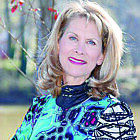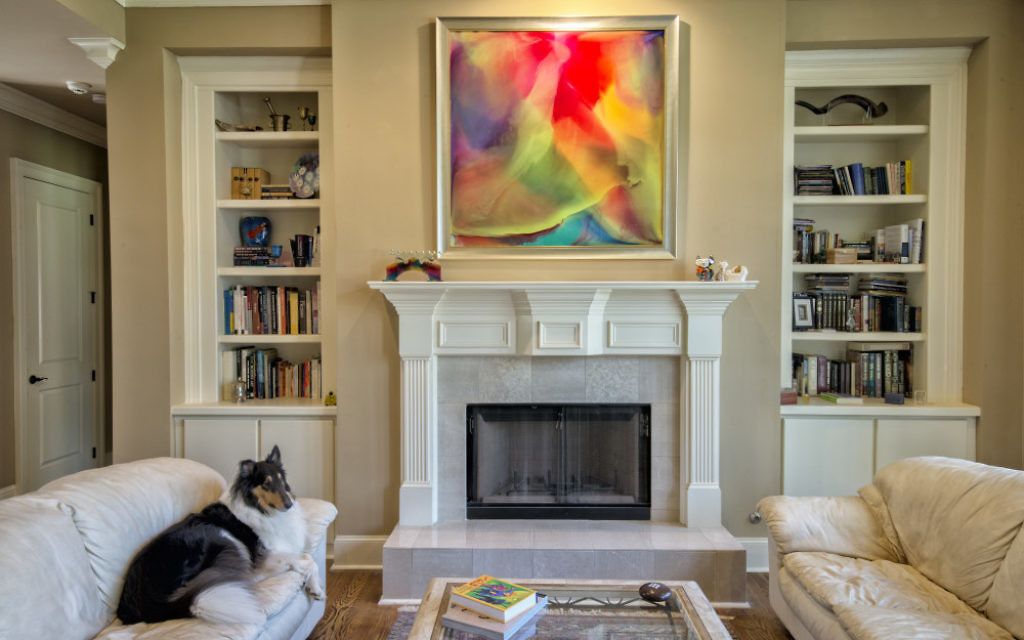Chai Style Art: Plexiglas, Paint Chips and Spiritual Inspiration
Sandy Springs creative gem Beth Shapiro, who moved here from San Antonio in 2009, has worked decades to hone her craft. Actually, “crafts,” as I most respect artists whose work transcends a uniform medium and style to include wood and plaster sculpture, stripe painting, charcoal, Plexiglas and Judaica.
Shapiro’s work bounces back abstract expressionism into bursting sprites of boomeranging, bleeding, singeing colors spilling, merging and dancing. Then there’s a cool, calculated, black-and-white number where tiny Hallmark logos are barely discernable, engineered among the ribbons.
Photos by Duane Stork unless otherwise noted
Get The AJT Newsletter by email and never miss our top stories Free Sign Up
—
Jaffe: How would you describe your technique and style?
Shapiro: I take my personal inspiration from mid-20th-century art: the abstract expressionists like Jackson Pollock and the color field painters (Barnett Newman, Helen Frankenthaler). I use modern materials to achieve a purity of color in my paintings. Believe it or not, some of this intensity is found only on the computer. By using Plexiglas as my “canvas,” the light passes through my translucent paint and glazes and comes back through again, making it look as if the painting is almost backlit.
Jaffe: Were you talented as a youngster growing up in Queens, N.Y.?
Shapiro: As a child I used to burn matches underneath paper or cardboard to get a black carbon coating on the paper, and then I’d scratch out charcoal drawings. I have a practical side with an M.B.A. in marketing communications; I went back for formal art education after I had a family and took seven years to get a bachelor’s in fine art. Both skills require a keen eye for design. My work has been represented at Mason Murer Fine Art, but I currently operate out of my house, doing what I enjoy along with commissioned pieces.
Jaffe: You are an observant Jew. How does this weave into your work?
Shapiro: I have done the Modeh Ani (morning) prayer for my own house and created a commissioned piece called “Aishet Chayil” (A Woman of Valor) for someone in the community. I have also painted custom hamsas for people in the community to give as bat mitzvah and wedding gifts. Then I have this “Ajna” piece over the fireplace. Although Ajna is not a Jewish concept, I felt it spoke of spirituality. Ajna is the sixth primary Hindu chakra or energy point in the body. I felt the title conveyed an idea representing emanations from the soul.
Jaffe: How long does it take to complete a piece, and how much do they sell for?

Shapiro: The largest piece I have done is 5 feet by 5 feet, which goes for around $7,000. It takes a month or so. It’s hard to pin down. … I spent three months on a smaller piece and sold it for $3,000. I work full time in marketing design for a commercial real estate firm, so I’m only in my studio about 10 hours a week.
Jaffe: You work in different media?
Shapiro: Yes, but I am primarily focused now on painting. But one of my favorite pieces is a wooden sculpture called “Full of Yourself.” I am now experimenting with different ways to manipulate my paint. This piece I am doing for a doctor’s office requires different panels (yellow, orange and green), then they have to be precisely synchronized and layered over each other. The lines are rigidly formed, but the paint is poured and spread with gravity, allowing chance to play a valid role in art making (like Dada, an avant-garde movement in the early 20th century that embraced chaos and rejected logic). I want people to react to the layers. The piece will serve as a screen to separate the entry area from the patient area.
Note this triptych of my collie, Luna, in action, which I did in charcoal.
Also the black-and-white piece over the Yamaha piano is a graphite-and-charcoal drawing titled “Ribbons and Bows.” Black and white has a certain indescribable energy to me.
Jaffe: Describe this large piece inspired by Hans Hofmann.
Shapiro: This piece is like a mosaic of the acrylic glazes I use, only the pieces have been collected over time from many paintings and put together in this mosaiclike structure. To me, it is very much inspired by Hofmann, who was a major influence on the abstract expressionists and taught many of them.
Jaffe: What goes on in your studio downstairs?
Shapiro: Some of that is proprietary, but what you do see are a lot of shattered paint chips and X-Acto knives. I love their color range and texture. My biggest challenge is keeping the chips from separating from the main body. I’m working on that. The earth-toned one in the guestroom has the effect of onyx and marble.
Jaffe: What advice would you give to budding artists?
Shapiro: Try to pull the most out of your media, and don’t be afraid to fail. Not necessarily in that order.






comments